Doctor who admitted first Clinical Center patient dies
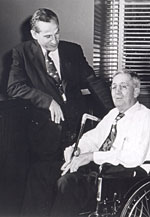 Dr. Roy Hertz (l), admitted the Clinical Center's first patient, Charles C. Meredith, on July 6, 1953.
Dr. Roy Hertz (l), admitted the Clinical Center's first patient, Charles C. Meredith, on July 6, 1953.
|
Dr. Roy Hertz, 93, a renowned NCI researcher who admitted the first patient to the
NIH Clinical Center in 1956, died on Oct. 28. A memorial service was held on Dec. 7
at the Clinical Center Chapel and attended by family, friends and colleagues.
"You often hear that someone's life ended before it should have," said Dr. John
Lewis, once a clinical associate of Hertz's. "But Roy Hertz got to follow the whole
trail-he had a good run from the top of the mountain."
Hertz came to NIH in 1941. He became chairman of the endocrinology section at the
National Cancer Institute, then NICHD's scientific director and then chief of
NICHD's Reproductive Research Branch. In 1956, through the sequential use of
two drugs, methotrexate and actinomycin-D, cures were achieved in up to 90
percent of women with choriocarcinoma who were treated by 1972; 90 percent
of those who were not treated died within a year. This was the first effective
chemotherapy for a solid tumor.
"It was the cure for choriocarcinoma and the precise measurement of tumor burden
by urinary gonadotropin assay that Roy perfected that actually led to treatment
for cure of other cancers, especially leukemias," said Dr. Stan Korenman, associate
dean for Ethics and Medical Scientist Training, University of California at Los
Angeles, School of Medicine. "I took care of a lot of women with choriocarcinoma,
and the change in their lives was the most dramatic event in my long medical career."
Dr. Hertz, who had an M.D. and a doctorate in physiology, was a professor of
obstetrics and gynecology at New York Medical College in Valhalla in 1972. Born
in Cleveland, he earned degrees in physiology and medicine from the University of
Wisconsin and a master's in public health from Johns Hopkins.
He married Pearl Fennell in 1934. She died in 1962. In 1965, he married Dorothy
Anne Wright Oberdorfer, who died Oct. 17. Surviving are two children from his
first marriage, Margaret Brodkin of San Francisco and Jeremy of Sebastapol, Calif.; a
stepson, Michael Oberdorfer of Dickerson, Md.; a stepdaughter, Barbara Verdin of
Chesapeake Beach, Md.; 13 grandchildren and nine great-grandchildren.
Back to Top
Making Clinical Center history . . . twice
Dr. Alter elected to Institute of Medicine
Dr. Harvey Alter made history last year by being the first Clinical
Center physician elected to the National Academy of Sciences.
And he's done it again, by being elected to the Institute of Medicine, a
unit of the National Academy of Sciences, making him the first physician
in Clinical Center history to be named to both academies.
"It's overwhelming," said Dr. Alter. "I feel guilty and undeserving, but
it is a really great honor."
Members are elected into the Institute of Medicine based on professional
achievement and demonstrated interest, concern and involvement with problems
and critical issues that affect public health.
Established in 1970 as a unit of the National Academy of Sciences, the Institute
of Medicine is broadly based in the biomedical sciences and health professions,
as well as related aspects of the behavioral and social sciences, administration,
law, the physical sciences, and engineering. It is concerned with the protection
and advancement of the health professions and sciences, the promotion of research
and development pertinent to health and the improvement of health care.
"The research I conduct is long term and has unpredictable payoffs, said
Dr. Alter. "Only at NIH could I have had the support necessary to achieve
these outcomes."
This marks Dr. Alter's fifth honor in two years. In 2000, he was awarded
the prestigious Albert Lasker Medical Research Award, and in 2002 he was
awarded The International Society of Blood Transfusion Presidential Award,
named Master of the American College of Physicians and elected to the
National Academy of Sciences.
Dr. Alter is chief of the infectious diseases section and associate director
of research in the Department of Transfusion Medicine. A native of New York
City, he earned his M.D. at the University of Rochester. He came to the NIH Clinical
Center as a senior investigator in 1969.
As a young research fellow, he co-discovered the Australia antigen, a key to
detecting the hepatitis B virus. Later, Dr. Alter spearheaded a project at the
Clinical Center that created a storehouse of blood samples used to uncover the
causes and reduce the risk of transfusion-associated hepatitis. Because of his
work, the U.S. instituted blood and donor screening programs that have served to
increase the safety of the blood supply.
Dr. Alter used this repository of clinically-linked blood samples to identify
another puzzling clinical problem. Most transfusion-related hepatitis was
found to be due to a virus different from the two then-known hepatitis agents,
A and B. Dr. Alter called this new form of hepatitis non-A, non-B hepatitis and
subsequently proved through transmission studies in chimpanzees that it was due
to a new agent. This eventually led to the discovery of the hepatitis C virus.
Back to Top
CRIS demos slated for January
Want to know more about the capabilities of the CRIS core system? Stop by
the Clinical Center Visitors' Information Center 2–4 p.m. on Jan. 14, 23, or
27 for hands-on demonstrations.
CRIS—the NIH Clinical Research Information System—is a $60 million project
that will tie together and support patient care, research and management
at the Clinical Center and the Mark O. Hatfield Clinical Research Center.
Work has begun on the largest component of CRIS, the core system that will replace
and expand the 25-year-old Medical Information System.
Dr. Stephen Rosenfeld, CRIS project manager, talked about the project in a
Dec. 18 Clinical Center Grand Rounds presentation, "An Information
Architecture for Clinical Research: Leveraging Technology to Speed Discovery."
The presentation can be viewed online at http://videocast.nih.gov/. Go to
"Past Events, Clinical Center Grand Rounds."
For more information about CRIS, go to: http://cris.cc.nih.gov.
Back to Top
Giving from the heart: NIH'ers help spread holiday cheer
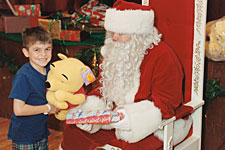 Children around the Clinical Center were all smiles this holiday season as NIH employees donated toys and dedicated their time to help children forget about their illnesses and enjoy the holiday.
Children around the Clinical Center were all smiles this holiday season as NIH employees donated toys and dedicated their time to help children forget about their illnesses and enjoy the holiday.
|
Jolly hearts and big smiles
The NIH Police and Fire Department received more than 500 toys from NIH employees
for their seventh annual Toys to Share Because We Care program. Nearly 400 employees
donated a bundle of Barbies, stuffed animals and board games to children throughout
the Clinical Center. Members of the Police and Fire Department along with Santa Claus
and the Washington Redskins Cheerleaders delivered toys to nearly 60 children.
Children who were hospitalized on Christmas day woke up to gifts around their bed.
"The NIH employees have always given generously," said Lt. Laurence Brown.
"They have a giving spirit and as our country continues to go through challenges,
NIH employees respond."

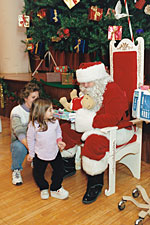
|
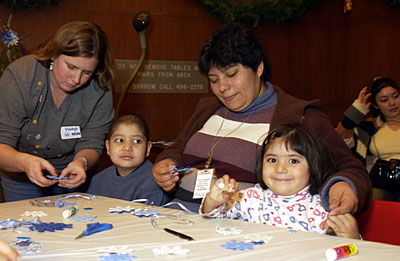 Erasmo and Paola Lopez participate in the "Holidays Around the World"
activity sponsored by the Pediatric AIDS Foundation. Members of the foundation
volunteered their services this holiday to help kids make holiday crafts.
Erasmo and Paola Lopez participate in the "Holidays Around the World"
activity sponsored by the Pediatric AIDS Foundation. Members of the foundation
volunteered their services this holiday to help kids make holiday crafts.
|
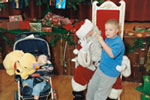
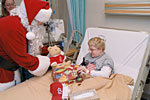
|
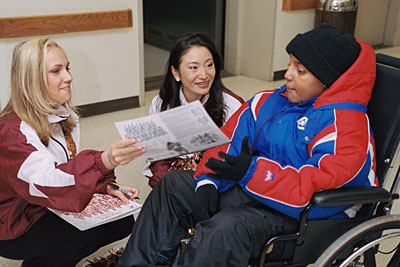
|
Back to Top
Children a world apart find common connection
 Music star Bono of the rock group U2 hugs NIH Clinical Center patient Lesley Clementi at the Dec. 10 airlift of shoe box gifts for Operation Christmas Child.
Music star Bono of the rock group U2 hugs NIH Clinical Center patient Lesley Clementi at the Dec. 10 airlift of shoe box gifts for Operation Christmas Child.
|
NIH patient selected as youth ambassador for international relief effort
For Lesley Clementi, turning 13 on Dec. 20, was a big deal, but this birthday was
extra special. While serving as a national youth ambassador this holiday season for
Operation Christmas Child, an international kids-helping-kids-relief effort, Lesley
joined hundreds of other children in New York City for an early December massive airlift
of gifts for African children with HIV/AIDS. Among those 83,000 gifts was a box Lesley
had personally packed with items she selected and a letter she had written. Lesley
didn't know that several folks were planning a surprise for her upcoming birthday.
". . . I am writing you because I know what it is like to have HIV
because I was born
with it. I want to let you know that I care for you and I always will no matter what
happens in our lives. I also have some advice to give to you that has helped me a
lot of times: never give up hope; always have faith and keep faith; if someone
chooses not to be your friend it's their loss not yours; you are always going
to have a friend, all you need in life is one, and here I am; if you
have a problem or any fears, turn to God and he will guide you; and last but not
least, another thing that helps me is to write letters to God explaining
what is hurting me. Love your friend, Lesley (Florida, USA)."
Lesley who is HIV positive has been an NIH patient for the past seven years.
She is currently in a research study in the HIV and AIDS Malignancy Branch, NCI.
In the study, children who have been treated for long periods of time with
combination therapy against HIV using a class of drugs targeting HIV called
protease inhibitors, are carefully followed to see how their immune system
responds to the therapy and whether the children develop any toxicities due
to the long-term therapy. The study is led by NCI principal investigator Dr.
Steve Zeichner. Lesley, accompanied by her mom, Tracey Dannemiller who is also
HIV positive, had her latest visit to the Clinical Center the day before her
birthday. She is a bundle of smiles and energy as she explains her motivation
for working with Operation Christmas Child. "This is for kids like me. I hope
these gifts in some small way help other kids with HIV/AIDS overcome the pain,
sadness and loneliness."
During her Clinical Center visit Lesley was a trooper as her nurse and doctor
performed the routine tests and blood draws, her upbeat attitude unwavering.
Helping with a project like Operation Christmas Child is typical of Lesley,
according to her mom. "She always wants to help. The ridicule and all the
negative things—this (the shoe box of gifts) was taking something so simple
and turning it into something so positive by bringing hope and joy to someone
who doesn't have much. Lesley truly has an amazing giving heart."
Nachos with cheese and soda and friends coming over were among Lesley's
birthday requests. She got that and a bit more. Courtesy of NBC Nightly
News team members and Operation Christmas Child representatives, Lesley was
surprised with a videotape of her gift box and letter being given to an
African child, who also is infected with HIV. She also received the
child's response letter. Lesley and her mom echo the same sentiment
about the birthday surprise, "awesome and special."
". . . I am a Ugandan girl with HIV. Nine years old. We lost our Daddy in
Nov. 1999 that was AIDS which killed him. I was told that my friend you're also
HIV+. Sorry for the problem but only Jesus cares about us-I have received my gift
from you. Thank you very much and I am asking our God lord to give you life so
you never know one day we will meet if God wishes. I have three sisters
and one brother. I am the second last born. I am unlucky because among
us I only found HIV+ with also my mum she is HIV+. We only thank God because
we are still alive. May God be with you, reward you and live
for long. Bye Bye, Emily (Kampala, Uganda)."
Worldwide, there are 42 million HIV-positive people.
According to a report by the United Nations' AIDS agency,
sub-Saharan Africa is home to 75 percent of HIV-positive people.
According to Dr. Zeichner, HIV-infected children in resource-rich
countries can often remain healthy for a long time, given the right
care, the proper choice of antiretroviral therapy and good adherence.
Children in poor countries however, confront a very different future.
"The gift that Lesley gave to a child in Uganda serves to connect these two
children with the same disease living in two very different worlds and
to highlight the differences in the care that they receive and the fates they face."
– by Dianne Needham
Back to Top
Celtic curse opens new doors for blood banks
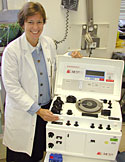 Dr. Susan Leitman believes that people with HH are a national asset.
Dr. Susan Leitman believes that people with HH are a national asset.
|
Blood bank benefits from new guidelines
In the cold, barren lands of northern Europe, where famines and warfare were common,
what is today regarded as a common blood disorder may have been a vital genetic defense
mechanism to help ensure survival under unusually harsh conditions. The mutation resulted
from two defective copies of a particular gene causing the intestine to absorb excessive
iron—a good thing if there's no food and frequent blood loss. But some of the
descendants of these northern Europeans today are suffering because of this mutation.
The condition was dubbed the "Celtic Curse" by some, but is more commonly known
today as hereditary hemochromatosis (HH). Its effects can be devastating: arthritis,
fatigue, heart palpitations, non-specific stomach pain, impotence, loss of
menstruation, and infertility. In advanced stages, the skin can take on a gray
or bronze hue and serious problems like cirrhosis of the liver, liver cancer,
diabetes, heart and joint disease, severe fatigue, cardiac arrhythmia, and
congestive heart failure may develop, resulting in disability or death.
"It's one of the most common genetic disorders in persons of northern European
Caucasian descent," said Dr. Susan Leitman, chief, Blood Services, Department of
Transfusion Medicine. "Many people don't even know they have it, although it
affects them from early childhood." According to Leitman, one in 200 people
in this category suffer from HH. She adds, it should be something that's tested
at infancy or in childhood.
"Many physicians are opposed to universal screening for HH because it labels people
as having a genetic disorder early on," she said, "and it might negatively affect
that person's ability to get health insurance." Such attitudes, she added, need
serious rethinking.
One reason she feels that way is because the treatment for this potentially
debilitating disorder is as simple as taking blood, a process blood donors know as
phlebotomy. In other words, the ancient practice of "bleeding" may have had a very
real foundation in medical science.
Although phlebotomies may be simple, they are not cheap. Bills for going in to have
blood removed in a doctor's office on a regular basis can quickly add up. On the
other hand, blood centers, increasingly hobbled by new restrictions on who can and
can't give blood, are facing record blood shortages. Leitman and other researchers
believe the time has come to stop viewing people with HH as sufferers and began
seeing them as a potential national asset.
"The fact is, we've taken a hit because of these restrictions," she said. "If a
person's been to England for greater than three months, or served more than six
months on a European military base, or resided in Europe for five years or longer,
they are unable to donate blood. These new policies have robbed us of many of our
best donors."
Because hereditary hemochromatosis is considered a disorder and those with it need
to have blood removed for therapeutic reasons, the Food and Drug Administration was
initially wary about letting them donate blood. People who want to donate because
they're doing something good for somebody else is one thing, it was reasoned. If
someone needs to give blood, their motivations may keep them from revealing details
that would otherwise prevent their blood from being accepted. Thus, any blood drawn
from HH subjects was tracked and, if used, the source of the blood had to be disclosed
to transfusion recipients in advance-more trouble than it was worth for most centers.
The impasse is real, but not insurmountable, Leitman said. In January 2001, the
Clinical Center's Department of Transfusion Medicine joined a growing number of
blood centers receiving waivers for the restrictions. But as with anything, there
were conditions.
First, all HH subjects must be treated free of charge whether or not they meet the
present criteria for donating blood. They must be under a physician's care, must have
a prescription for phlebotomy treatment written by a physician and must undergo
periodic monitoring of blood iron levels. In return, the blood that is removed
therapeutically can be made available for transfusion into others.
"In every way this is a win-win situation," Leitman said. "All that's required is
a simple finger-stick blood test at the time of phlebotomy to see if the hemoglobin
is high enough to donate. Schedules are established, there are fixed guidelines
for monitoring, and the care is streamlined and standardized."
Since January of last year, the Clinical Center's blood bank has accrued 116 new
subjects-one of the fastest accruals ever. Word is spreading by the Internet,
newsletters and articles, and word of mouth. Organizations such as the American
Hemochromatosis Society, Iron Overload Disorders Organization and Iron Disorders
Institute have also spread the word. The stipulations surrounding the use of HH
donor blood for transfusion guarantee an increase in the amount of usable blood
for blood banks and hospitals. At the same time, the guidelines remove any
incentive on the part of the donors to hide risk factors that may make them
ineligible for donation.
Phlebotomy treatments do not stop once excess iron has been removed. Leitman recommends
that iron levels continue to be monitored throughout life in people with HH, and
that phlebotomy treatments continue, at a slower pace, to prevent iron reaccumulation.
"The problems associated with hereditary hemochromatosis can be prevented
simply by keeping the iron from accumulating," Leitman said. "The treatment
is simple, highly effective, and has been known and available for more than 50 years."
– by John Iler
Back to Top
West Nile Virus observed in MRI images
Extensive changes in deep brain tissue or gray matter caused by West Nile Virus
(WNV) encephalitis have been observed in magnetic resonance images for the first time.
That finding is described in a case report from scientists at the NIH Clinical Center.
Using serial magnetic resonance imaging, physician-researchers monitored West Nile
disease progression in a 55-year-old white male. MRI was conducted six times over
approximately five weeks (days 5, 8, 11, 18, 23, and 37). Deep gray matter involvement
in WNV encephalitis was not found until day 11 of fever—day 7 of neurological symptoms.
"The serial images enabled us to follow the disease progression over a protracted timeframe.
This aids us in understanding the impact on brain function," said John A. Butman, M.D.,
Ph.D., staff neuroradiologist, Diagnostic Radiology Department, Clinical Center.
Dr. Butman and co-authors Juan C. Gea-Banacloche, M.D., Michael W. Haley, M.D., Paul A.
Nyquist, M.D., and Avi S. Retter, M.D. presented the case report at the 88th
Scientific Assembly and Annual Meeting of the Radiological Society of North America
held Dec. 1–6, in Chicago.
According to the case report, the MRI findings lag behind the clinical picture
of WNV encephalitis, indicating that a patient's condition can be much worse
than initial MRI findings suggest. "Progression of disease may be seen on MR
examination between days 7 and 14," said Dr. Butman.
The researchers noted that the sites of brain involvement with WNV encephalitis
have a high overlap with viruses in the same family, and produce similar symptoms.
"St. Louis encephalitis is like WNV encephalitis in that it is very unusual to have
early MRI findings, whereas Japanese encephalitis often has early MR findings,"
said Dr. Butman.
The most serious consequences of WNV, which is typically asymptomatic or accompanied
by mild, flu-like symptoms that last a few days and do not appear to pose any
long-term health threat, are encephalitis and meningitis. However, explained
Dr. Butman, an estimated 1 in 150 WNV cases become clinically apparent with
neurological symptoms. Of those cases approximately 50 percent develop into
encephalitis.
Most often found in Africa, Asia and the Middle East, WNV has been in the U.S.
since mid-1999 or earlier, according to the Centers for Disease Control.
In a 1999 New York City WNV outbreak, MRI documented evidence of meningitis
but did not observe infection of the brain tissue. "It is likely that
encephalitis was present but undetected visually by MRI," said Dr. Butman.
A normal MRI does not exclude WNV encephalitis, Dr. Butman pointed out.
"This report reinforces that there can be very subtle findings of the
disease early on in WNV. The absence of MRI visible disease does not indicate
disease status," he said. He added that a negative initial MRI is to be
expected with WNV encephalitis and that there may be fairly extensive
disease present in the brain despite a negative MRI. "The consequences of
what was likely there from the start may be seen in a week or two."
The case report's results, emphasized Dr. Butman, do not render the
initial MRI irrelevant. While physicians wait for spinal fluid pathology results, MR findings can be
used to rule out the presence of other neurological disease with overlapping
symptoms. "This case gives us the knowledge that MRI is not particularly
sensitive to the type of infection caused by WNV encephalitis. Consequently,
fairly extensive progression occurs before the disease becomes visible," he said.
– by Dianne Needham
Back to Top
And the prize goes to . . .
Amanda Caruso,10, was one of the winners of the Department of Laboratory Medicine's
annual holiday raffle. Amanda bought six tickets for $5 and won a 20-lbs basket of
chocolate, cookies and coffee. The basket was donated by the Social Work Department.
Three other baskets, donated by DLM, and one other donated by the local community
were won by Sharon Wentcel, Sue Frodigh, Becky Kazebee, and Quandra Freeman. Amanda
is one of the youngest winners in the history of the 30-year fundraiser. DLM holds
its annual holiday fundraiser to benefit the Friends of the Clinical Center and the
Patient Emergency Fund. This year, they raised $3,900.
|

